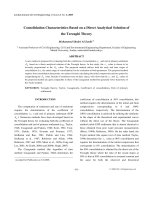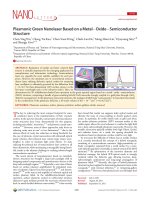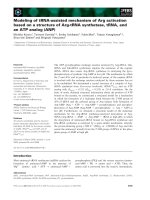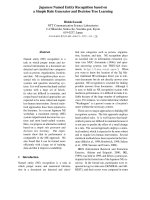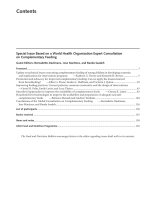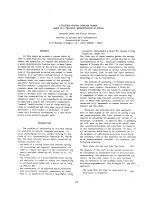Fuel economy improvement based on a many-gear shifting strategy
Bạn đang xem bản rút gọn của tài liệu. Xem và tải ngay bản đầy đủ của tài liệu tại đây (344.54 KB, 14 trang )
I
NTERNATIONAL
J
OURNAL OF
E
NERGY AND
E
NVIRONMENT
Volume 3, Issue 4, 2012 pp.577-590
Journal homepage: www.IJEE.IEEFoundation.org
ISSN 2076-2895 (Print), ISSN 2076-2909 (Online) ©2012 International Energy & Environment Foundation. All rights reserved.
Fuel economy improvement based on a many-gear shifting
strategy
B. Mashadi
1
, R. Baghaei Lakeh
2
1
School of Automotive Engineering, Iran University of Science and Technology, Tehran, Iran.
2
Department of Mechanical Engineering, Southern Illinois University, Edwardsville, USA.
Abstract
Considering the engine operating condition in terms of engine load and engine speed, a fuzzy decision
making system has been developed. The objective was to controlling the engine operating point in the
engine torque-rpm map, in order to enhance fuel economy. The main idea stems from the approach of
tracking the defined target curve in the engine map similar to the CVT control criteria. To provide
resemblance between a traditional geared transmission and a CVT, a many-gear transmission concept
was introduced. A Fuzzy control was utilized by defining proper membership functions for the inputs
and output. The efficient fuel consumption curve in the engine map was taken as the target of controller.
The effect of engine output power on fuel consumption has also been taken into consideration. Making
use of ADVISOR software, vehicle simulations was performed for the many-gear base case and a very
good consistency was found with the CVT case. As a result the fuel consumption was found to become
considerably less than existing values. The developed strategy was then applied to other cases including
conventional manual and automatic transmissions and improvements in the fuel economy was observed.
Copyright © 2012 International Energy and Environment Foundation - All rights reserved.
Keywords: Gear shifting strategy; Fuzzy control; Fuel economy; AMT; AT.
1. Introduction
Passenger comfort and fuel efficiency have always been two important subjects in automotive design
industry. Although the driving of a car equipped with a manual transmission may be pleasant on
highways, the situation is completely opposite inside large cities due to heavy traffic. Automatic gear
shifting systems including conventional Automatic Transmissions (AT), Automated Manual
Transmissions (AMT) and Continuously Variable Transmissions (CVT) are proper solutions to tackle
this problem. Moreover, strict regulations on emission reduction in one hand and fuel economy on the
other hand are additional driving forces towards new solutions.
An important subject in automatic transmission design is gear shifting schedule which determines
shifting times according to a predefined strategy. Among the various kinds of strategies investigated by
designers and researchers in many years, only a limited number of publications is available to the public.
Xiafeng et al [1] have established the dynamic torque and fuel consumption models of engine, described
by a multilayer feed-forward neural network. They have calculated the optimal dynamic and economical
shift schedules with a 3-parameter model. The automatic shift schedule has taken the influence of
acceleration of vehicle into consideration and improved the vehicle fuel economy compared with
conventional 2-parameter schedules up to 1.8%.
International Journal of Energy and Environment (IJEE), Volume 3, Issue 4, 2012, pp.577-590
ISSN 2076-2895 (Print), ISSN 2076-2909 (Online) ©2012 International Energy & Environment Foundation. All rights reserved.
578
Nelles [2] has proposed a new driving strategy called IntelligenTip, which is capable of learning from
driver's style of driving via +/- buttons whenever the automatically selected gear seems inappropriate.
The core of this method is the fuzzy systems whose membership functions are adapted. This approach
offers a number of advantages such as the stable and fast convergence to the unique optimum. It is
demonstrated that the strategy yields an individualization of the shift behaviour and is robust with respect
to different driver types.
Hayashi et al [3] have designed an optimal transmission controller using a Neuro-Fuzzy approach for an
automobile with variable loads. The vehicle loads and driver's intention are estimated from the signals of
the status sensors by fuzzy logic. Then a neural network is fed by these data and an experienced driver
teaches it to act in an optimal gear shifting manner such that a vehicle operator feels comfortable even
during automobile load changes.
A tabular approach was proposed by Qin et al [4] for cruise control gear selection based on offline
calculations. A table is chosen at the time of decision making according to the driving condition. Each
table contained shifting boarders in vehicle load-speed map obtained from empirical experiments. Yang
et al [5] have investigated driver’s actions on accelerator and brake pedals and tried to categorize these
actions for gear shifting purposes.
Using engine state and driver's intention, Mashadi et al [6] have discussed a gear shifting strategy with
the application of fuzzy control method using a two-layer controller. In the first layer two fuzzy inference
modules were used to determine necessary outputs and in the second one the decision of shifting was
made by upshift, downshift or maintain commands. The behaviour of fuzzy controller was examined by
making use of ADVISOR software. The dependency of fuel economy to the driving cycles and in turn
the influence of traffic conditions is also taken into consideration by Montazeri and Asadi [7].
In the current work, a gear shifting strategy with emphasis on fuel economy has been developed and
Fuzzy decision making rules have been utilised. This approach is derived from the very concept that only
a CVT can follow the desired working points on the engine Torque-RPM map. In order to make this
approach applicable to conventional transmissions, a many-gear transmission concept has been
established.
2. Fuel economy and gear shifting effects
Many approaches are known as feasible to improve fuel economy of a ground vehicle; including
optimization of intake & fuel injection systems, increasing volumetric efficiency, optimising combustion
chamber, etc. With the application of these methods, the structure and performance of the engine will
directly be affected and fuel consumption map will be so amended that more areas of Torque-RPM map
is assigned to fuel efficient points. By means of these concepts, one can expect reductions of fuel
consumption up to 10% [8].
In addition to these techniques which obviously influence the function of the engine itself, it would also
be possible to optimize the manner in which the engine is utilized during driving. Improvement of power
train system is a method of optimizing the engine operating regimes. Possible modifications of power
train systems can be divided into hardware and software categories. The hardware modifications affect
the structure and mechanism of the power train system and involve selection of different transmission
types and gear ratio design. These types of conceptual and structural modifications of power train system
are believed to improve the fuel economy by 3 to 8% [8]. Software modifications, on the other hand are
only applicable in Automatic Transmissions (AT), Automated Manual Transmissions (AMT) and
Continuously Variable Transmissions (CVT), where making decision on gear shifting and proper
position of Engine Operating Point (EOP) is performed by a control unit. Considering diverse factors
selected by system designer (e.g. engine speed, engine load, vehicle speed, throttle angle, accelerator
pedal angle and brake pedal angle, etc) and according to the shifting strategy, control unit determines the
suitable shift action which can be upshift, downshift or no shift. The shifting decision can directly affect
the EOP and therefore is a practical way to control the engine state using the software adjustment.
Engine state or EOP is not only related to transmission ratio but also several other factors like road
condition and driving habit. The software modifications such as geared transmissions' shifting plan can
improve the fuel economy by 0.5 up to 2% [8].
3. Vehicle simulation
In order to simulate the performance and fuel consumption of the vehicle, ADVISOR software has been
utilized in this work. This program uses backward, semi-static approach and is able to simulate the
International Journal of Energy and Environment (IJEE), Volume 3, Issue 4, 2012, pp.577-590
ISSN 2076-2895 (Print), ISSN 2076-2909 (Online) ©2012 International Energy & Environment Foundation. All rights reserved.
579
vehicle motion in defined driving cycles. Conventional shifting map of transmission in the software,
which defines the points of shifting according to engine torque and speed in form of diagonals is adopted
as basic form for both Automatic and Automated Manual transmissions. Each diagonal defines the shift
action point from existing gear number to the previous or next one. Usually, the conventional shifting
maps are based on vehicle performance rather than fuel economy; although some modifications are
possible to combine performance oriented and fuel economy oriented shifting maps [1, 2]. In manual
transmissions, decision of shifting is made by driver, who applies her/his experience to determine the
point of shifting, thereby it is hard to expect fuel efficient shifting plan.
3.1 Manual 5-step transmission
As a reference, a vehicle with specified characteristics and a 5-step Manual Transmission has been
simulated while tripping NEDC driving cycle using ADVISOR default shift map By means of this
simulation, the placement of EOPs has been recorded in Torque-RPM map and also the nominal engine
fuel consumption has been calculated. Comparing the placement of EOPs with the specific fuel
consumption contour, as shown in Figure 1, one can simply observe how the operating points are
scattered during vehicle motion. EOPs are extended in direction of RPM axis as a result of gear shifting
(caused by sudden change of engine speed) and the smooth acceleration of vehicle in an engaged gear.
The same diversity exists in the direction of torque axis which is caused by engine load changes during
the trip. The variation of engine load is normally imposed by driver and road conditions. In the area of
negative torques, a concentration of operating points which are resulted in various engine speeds can
clearly be seen. This could be recognized as a result of engine operation during vehicle deceleration with
closed throttle. In such condition, braking effect of engine will be appeared because of opposite direction
of power flow. Although the engine load is very small in this state, fuel consumption is not desired due to
poor engine specific fuel consumption.
Figure 1. EOP placement of ADVISOR default shifting map for MT
International Journal of Energy and Environment (IJEE), Volume 3, Issue 4, 2012, pp.577-590
ISSN 2076-2895 (Print), ISSN 2076-2909 (Online) ©2012 International Energy & Environment Foundation. All rights reserved.
580
3.2 Manual 5-step transmission
In another approach [6], default shifting map of ADVISOR has been replaced by a set of fuzzy decision
making rules. Driver's intention is the major factor in setting the fuzzy rules of this strategy. It should be
noted, that fuel consumption of vehicle has not been taken into consideration. Figure 2. shows the range
of EOPs resulted from running the same vehicle and gearbox in NEDC driving cycle using modified
strategy.
Figure 2. EOP placement of driver’s intention shifting strategy [6] for MT
Comparing the results of the two simulations reveals differences in the scatterings of operating points in
engine Torque-RMP map for the two cases. Operating points are mostly extended in high engine speed
ranges and small number of points is located near to fuel efficient area of the map. Running the engine in
full load condition, which happens during this simulation, completely deteriorates the fuel economy due
to high engine torque and speed. Poor fuel economy of this method could be predictable because the
developed fuzzy controller was intended to reflect the driver's needs by processing the incoming signals
from accelerator and brake pedals; consequently fuel consumption of the vehicle was not concerned.
3.3 Conventional 4-step automatic transmission
Besides limit losses in gears and bearings, an inevitable loss will occur in this case because of poor
hydraulic performance of torque converter. The imposed loss leads to decrease of transmission overall
efficiency and fuel economy. Shifting map of these transmissions in ADVISOR has been defined as
diagonals in Torque-RPM map of engine which is a common method; however these diagonals could be
considered in Throttle-Vehicle speed map too. In order to compare the fuel consumption of the same
vehicle, equipped with a conventional Automatic Transmission, an adapted simulation has been
performed. Figure 3. shows the placement of EOPs of the vehicle running in NEDC driving cycle. The
EOPs are clearly more spread in various engine speeds compared with those of 5-step manual
transmission. The reason for this difference can be justified owing to less gear steps and in turn increase
of gear ratios between following gears and eventually uncontrollable jumps of EOP during gear shiftings.
These jumps can result in poor fuel efficiencies of the vehicle as illustrated.
International Journal of Energy and Environment (IJEE), Volume 3, Issue 4, 2012, pp.577-590
ISSN 2076-2895 (Print), ISSN 2076-2909 (Online) ©2012 International Energy & Environment Foundation. All rights reserved.
581
Figure 3. EOP placement of ADVISOR default shifting map for AT
4. Shifting strategy based on fuel economy
In order to apply an interface for making gear shifting decision, the default algorithm of ADVISOR was
replaced by a Fuzzy module which uses MIN/MAX or Mamdani inference method. Figure 4 shows the
schematic of reformed transmission control box of software after applying a Fuzzy interface module.
Upshift, downshift or noshift decisions are made according to input values and governing rules.
Figure 4. Reformed transmission control box of ADVISOR
